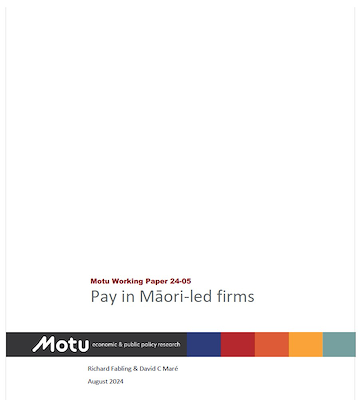
This research, conducted by Richard Fabling and David C Maré, of Motu Economic and Public Policy Research (Motu Research), explores the wages of Māori kaimahi working within highly productive Māori-led firms.
Motu researchers find Māori-led firms hire more Māori kaimahi: suggest developing policies and programmes to improve employment conditions.
Are highly productive Māori-led businesses passing financial benefits on to their Māori employees? This is the question which motivated Fabling and Maré’s 2024 research, Pay in Māori-led firms, funded by Te Puni Kōkiri.
Māori businesses often have a unique approach to measuring success. Rather than exclusively focusing on financial growth and profit, Māori firms often prioritise social outcomes and benefits for their communities. Researchers, Fabling and Maré, wanted to investigate this further when diving into this kaupapa.
Findings and insights
These findings construct a foundation from which to explore possible policy initiatives and programmes to help assist Māori-led businesses and Māori kaimahi. Much of the data suggests focusing on employment conditions surrounding wages, particularly when it comes to firms that do not have working proprietors.
Proprietor-led firms are businesses and organisations within which the founder plays a significant role in the business operations, processes and strategy. This analysis highlights that Māori-led firms have slightly lower than average multi-factor productivity and wage levels compared to non-Māori proprietor-led firms. However, the research does indicate some positive variation in other areas of business and staff operations.
The research showed the known trend of Māori-led firms employing proportionately more Māori staff than other firms. However, most jobs held by Māori (65%) are in firms where the proprietor does not work in the business. This applies equally in both Māori-led and non-Māori-led firms.
The research also notes, “moving from [proprietor-led] firms to employee-only firms is associated with relatively large gains” for kaimahi wages. Alongside these analysed transitions, “the strongest gains are for employees moving from Māori-led firms.” Overall, highlighting that employee-only firms generally pay relatively high wages, compared to Māori-led proprietor-led firms.
While we are aware of the importance of supporting Māori-owned and operated businesses, which employ Māori in greater numbers, the research suggests larger firms (i.e. where the proprietor doesn’t work in the business) are equally important when considering programmes to uplift Māori employment. For example, initiatives which encourage in-work upskilling in large institutions may provide a stronger pathway for Māori into skilled employment.
Fabling and Maré also explore several other aspects of Māori wage rates and firm productivity. Finding that “young workers move between jobs in a way that, on average, moves them into better performing and better paying jobs,” and that “for tāne Māori, there is a clear pattern of moving to higher-paying firms throughout their working life … [However, for] wāhine Māori, there is a strong pattern of moving to better paying firms until about age 30, [with] only small or negative changes after that”. It is suggested that future research investigate the reasons behind this gendered difference, with whānau-based decisions being identified as a potential influence.
The working paper ‘Pay in Māori-led firms’ can be found on Motu’s website - Pay in Māori-led firms | Motu
- About: Education and Employment
- Published in 2025